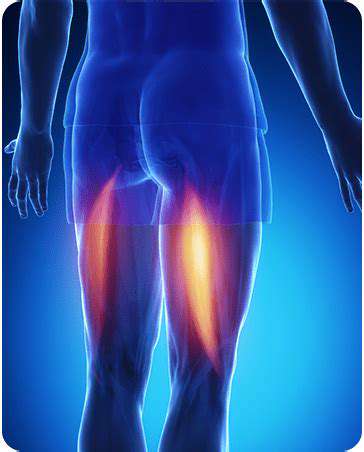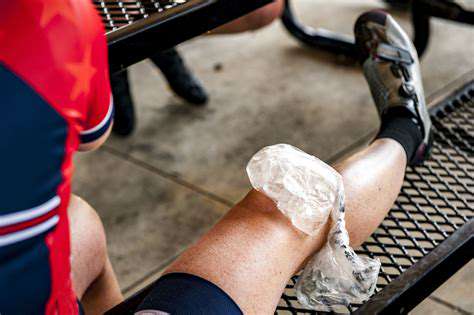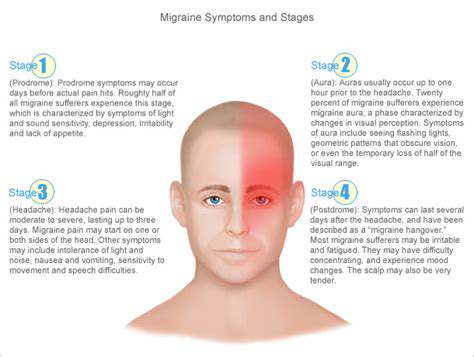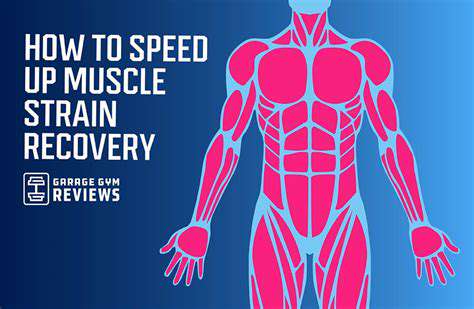Identifying and Managing Muscle Strain: Causes, Symptoms, and Treatment Options
What Causes Muscle Strain?
Common Causes of Muscle Strain
Muscle strain is commonly caused by overexertion or excessive stretch of the muscle fibers. This often occurs during physical activities that involve sudden movements or heavy lifting. High-impact sports such as football, basketball, and weightlifting are notorious for leading to strains.
Poor conditioning or lack of adequate warm-up can also contribute to muscle strain. When muscles are not properly prepared for intensity, they are more vulnerable to injuries. Stretching prior to exercise can help enhance flexibility and reduce strain risk.
Another significant cause is improper technique during exercise or sports. For instance, lifting weights with incorrect form can place undue stress on muscles, making them susceptible to strain. Ensuring that individuals are trained in the correct movements is essential for injury prevention.
Additionally, chronic muscle fatigue can be a precursor to strains. When muscles are continuously taxed without adequate recovery, they lose their ability to handle stress, leading to injury. It's vital for athletes and active individuals to schedule rest periods to allow muscles to recuperate.
Lastly, previous injuries can increase the risk of future strains. Once a muscle has been injured, it may have weakened or altered biomechanics, making it more prone to re-straining. Thus, it’s important to address any prior injuries before resuming activity.
Recognizing the Symptoms of Muscle Strain
The initial symptom of a muscle strain is often a sudden sharp pain in the affected muscle. This pain may be accompanied by swelling and bruising as the injury develops. Early recognition of these signs can aid in prompt treatment.
In addition to localized pain, a reduced range of motion is commonly observed in strained muscles. This may manifest as difficulty moving the affected muscle or joint, and attempting to use it may exacerbate the pain.
Another symptom includes muscle spasms, which occur when the muscle involuntarily tightens. This can cause further discomfort and limit mobility, making it essential to address both the pain and the spasms.
Individuals may also experience tenderness when pressing on or moving the muscle. Touching the area around the strain can elicit pain, indicating inflammation and irritation in the muscle fibers.
In severe cases, individuals may observe a visible deformity or weakness in the affected area. This is often indicative of a more serious strain or tear, signaling a need for medical evaluation and intervention.
Treatment Options for Muscle Strain
The primary treatment for muscle strain is the R.I.C.E. method: Rest, Ice, Compression, and Elevation. Resting the affected muscle prevents further injury and promotes healing. Ice application helps to reduce swelling and numb the pain.
Compression with wraps or bandages can support the injured area, minimizing swelling while providing stability. Elevating the muscle above heart level is also beneficial for reducing swelling in the immediate aftermath of a strain.
Nonsteroidal anti-inflammatory drugs (NSAIDs) can be prescribed or taken over the counter to alleviate pain and inflammation associated with muscle strains. However, caution should be taken with any medications, particularly regarding prolonged use.
For more significant muscle strains, physical therapy may be recommended. A physical therapist can develop a rehabilitation program specifically tailored to restore strength and flexibility in the injured muscle, often incorporating gradual stretching and strengthening exercises.
In cases of severe strain where complete recovery is hindered, surgical intervention may be necessary. Surgeries aim to repair torn muscle fibers or tendons, thereby facilitating optimal function and reducing the risk of further injury.
Recognizing the Symptoms of Muscle Strain

Understanding Common Symptoms
Muscle strain often manifests through visible signs and discomfort. Common symptoms include swelling, bruising, and limited ability to move the affected area. Experiencing pain during movement can indicate the severity of the strain. Patients may also report stiffness and tenderness around the injured muscle.
A key symptom to look out for is muscle spasms, which can cause involuntary contractions that lead to further discomfort. These spasms may vary in intensity, sometimes making it difficult to engage in daily activities. Keeping note of any progressive symptoms can help in assessing the injury's seriousness.
It’s important to differentiate between mild, moderate, and severe strain based on symptoms. Mild strains may only cause slight discomfort, while severe strains can result in extreme pain that makes it hard to function. Being aware of how symptoms develop can aid in timely intervention.
If symptoms persist or worsen over time, seeking medical attention is crucial. Early diagnosis can lead to better outcomes and prevent further injury.
Identifying the Cause of Muscle Strain
Muscle strains typically arise from overexertion, awkward movements, or accidents during physical activity. Understanding the cause can significantly aid in recovery and prevention efforts. Activities that involve heavy lifting or abrupt changes in direction are common culprits.
Additionally, lack of proper warm-up before rigorous exercise can lead to strains. It’s essential to prepare your muscles adequately to handle the stress of workouts. Ensuring you engage in stretching exercises is a vital step in prevention.
Repetitive motions, such as those found in certain sports or occupational tasks, can also contribute to muscle strain. Identifying these activities will help you devise strategies to minimize risk. Variation in training and proper rest are crucial to avoid strain-related injuries.
Learning about personal fitness levels and recognizing limits is vital. Consulting with a fitness expert can provide personalized insights to help prevent future strains.
The Role of R.I.C.E in Treatment
The R.I.C.E method—Rest, Ice, Compression, and Elevation—is a fundamental approach to managing muscle strain. Resting the affected muscle allows for natural healing without further injury. Ice application can reduce swelling and numb severe pain.
Compression involves using bandages or wraps to support the injured muscle, which can also help in minimizing swelling. It is vital to ensure that compression is not too tight, as this may impede circulation.
Elevation, or holding the injured area above heart level, further aids in reducing swelling by allowing fluids to drain away from the injury site. Implementing R.I.C.E consistently can significantly speed up recovery time.
It’s advisable to follow R.I.C.E for the first 48 hours post-injury. Afterward, transitioning to gentle stretching and strengthening exercises can promote better healing and restore mobility.
When to Seek Professional Help
While many muscle strains can be managed at home, certain signs indicate the need for professional evaluation. If severe pain persists for more than a few days, or if the inability to use the muscle affects daily activities, consulting a healthcare professional is essential.
Significant swelling, bruising, or a noticeable deformity in the muscle can also warrant a visit to a medical expert. Early diagnosis may facilitate a more straightforward recovery pathway. Some strains might be more severe than they initially appear and may require a different treatment approach.
Additionally, if there's no improvement after several days of home treatment, an evaluation by a physical therapist or sports medicine specialist should be considered. These professionals can provide advanced therapeutic options such as physical rehabilitation programs.
In cases where an underlying injury, such as a ligament tear, might be the cause, imaging tests may be required. Timely intervention can prevent chronic issues later in life.
Long-term Management and Prevention Strategies
After recovering from a muscle strain, focusing on long-term management is essential to avoid re-injury. Regular strength training can increase muscle resilience, making them better equipped to handle strenuous activities. Balancing different types of exercise can help in building overall muscle strength.
Incorporating flexibility and mobility training can greatly improve muscle function. This may involve dynamic stretching before exercises and static stretching afterward to promote flexibility. Commitment to a well-rounded fitness routine is crucial for long-term injury prevention.
Understanding the importance of gradual progression in physical activities will also help in managing strain risk. Increasing intensity or duration of workouts slowly allows muscles to adapt without undue stress.
Finally, listening to your body is key. Recognizing warning signs of fatigue or discomfort will enable proactive measures to prevent injuries before they occur.
Treatment Options for Muscle Strain
Understanding the Types of Muscle Strain
Muscle strains are categorized into three grades—Grade I, Grade II, and Grade III—each differing in severity. Grade I strains involve mild stretching or minor tears in the muscle fibers, leading to slight pain and minimal loss of function. These strains typically heal quickly with simple rest and self-care measures.
Grade II strains present a more significant tear, resulting in moderate pain, swelling, and some loss of strength. This level may require medical evaluation and a tailored rehabilitation plan to ensure proper healing. Lastly, Grade III strains are the most severe, involving complete tears and potentially rupturing the muscle. These injuries often necessitate surgical intervention and a more extensive recovery period.
Common Causes of Muscle Strain
Muscle strains can occur due to various factors, including overexertion, improper lifting techniques, or engaging in sports without adequate warm-up. Athletes and individuals who participate in physical activities that require sudden bursts of movement are particularly susceptible to muscle strains.
In addition to physical activity, muscle imbalances or flexibility issues can also contribute to the likelihood of strain. Poor conditioning, fatigue, or muscle tightness can further increase the risk, highlighting the importance of maintaining a well-rounded fitness routine that includes stretching and strength training.
Recognizing Symptoms of Muscle Strain
The primary symptoms of muscle strain include sudden pain in the affected area, swelling, bruising, and limited mobility. Often, the pain may worsen with movement or activity, making it essential to recognize these signs early on.
In some cases, muscle strains may also present with muscle spasms or a "popping" sensation at the time of injury. Being aware of these symptoms can help individuals seek timely medical attention and take necessary precautions to prevent further injury.
Effective Treatment Strategies for Muscle Strain
Treatment for muscle strains often begins with the R.I.C.E. method, which stands for Rest, Ice, Compression, and Elevation. This approach helps to reduce pain and swelling while promoting healing. Over-the-counter pain relievers may also be beneficial in managing discomfort during the recovery process.
For more severe strains, physical therapy may be recommended to regain strength and flexibility in the affected muscle. In cases where surgery is needed, a rehabilitation program will be crucial for a successful return to normal activities. Consulting a healthcare professional is key to determining the most appropriate treatment plan based on the degree of strain.
Preventing Muscle Strains

Understanding Muscle Strains
A muscle strain, commonly referred to as a pulled muscle, occurs when muscle fibers are stretched or torn due to excessive force. These strains can happen during physical activities such as lifting heavy weights, sports, or even during simple movements like bending down.
Muscle strains can be categorized into three grades: Grade I involves mild stretching, Grade II indicates partial tears, and Grade III represents complete tears. Recognizing the grade of a muscle strain is essential for determining the appropriate treatment.
Common Symptoms of Muscle Strains
The symptoms of a muscle strain can vary depending on the severity of the injury. Common signs include localized pain, swelling, and bruising around the affected area. In more severe cases, there may be a noticeable loss of strength or flexibility in the muscle.
Additionally, individuals may experience muscle spasms or difficulty using the affected limb. It is crucial to assess these symptoms promptly to initiate appropriate care and recovery strategies.
Treatment Options for Muscle Strains
Effective treatment for muscle strains depends on the injury's severity but typically includes rest, ice application, compression, and elevation (RICE). This conservative approach helps reduce inflammation and pain, facilitating a faster healing process.
In more severe cases, physical therapy might be recommended to restore strength and flexibility. Over-the-counter pain relievers can also assist in managing discomfort during the recovery phase.
The Role of Warm-Up and Cool-Down
Incorporating proper warm-up and cool-down routines is essential in preventing muscle strains. Warm-ups increase blood flow to the muscles, preparing them for high-stress activities. Engaging in dynamic stretches beforehand can significantly reduce the risk of injury.
Cooling down after exercising helps to gradually lower the heart rate and stretch the muscles, further preventing strains and promoting recovery. Establishing these routines can make a noticeable difference in overall muscle health and athletic performance.



